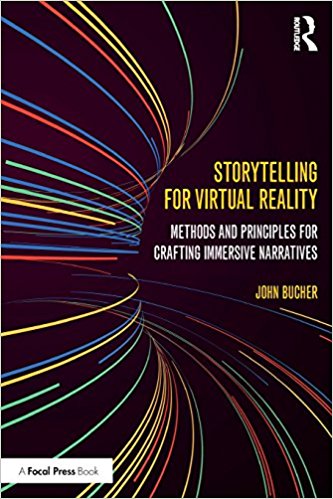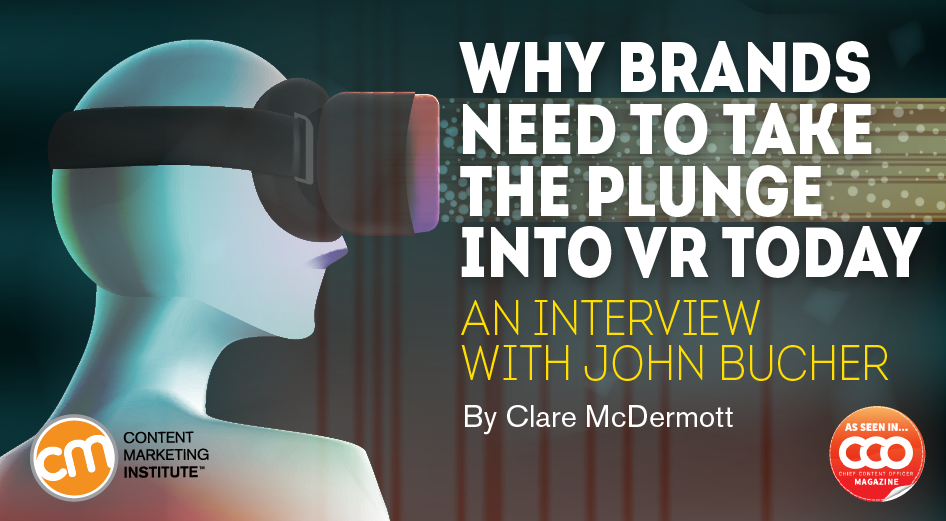John Bucher, virtual reality producer and consultant, makes the case for trying the medium even if it’s not fully ready for prime time, with examples of brands actively experimenting with virtual and augmented reality. It’s a new language for communicating with audiences, and brands are still figuring out how to best tell stories with this new medium. John: There are brands doing interesting things with VR. The New York Times is a great example, but even brands like Nike are using VR in interesting ways. John: I think it’s more exciting to look at the companies doing innovative things with augmented reality (AR) in the current space. Some of the fashion magazines are offering opportunities for advertisers to align products with editorial in the same issue. In all these examples, when you’re able to take what has been a static image and create something that has dynamic motion, it’s of high interest to advertisers. CCO: What do you find particularly exciting about this moment in VR adoption? John: AR is similar to VR in many ways but there are some specifics that differentiate the two, especially if you’re trying to tell a story to your audience using AR. John: I’m interested in seeing how VR will play a part in making the world a better place.

In late 2016, pundits declared 2017 whould be the year virtual reality won mass adoption. And yet here we are, well into 2018, still waiting for it to fully materialize.
Are we kind of, nearly, almost there? John Bucher, virtual reality producer and consultant, makes the case for trying the medium even if it’s not fully ready for prime time, with examples of brands actively experimenting
with virtual and augmented reality.
But before we begin, let’s get a couple definitions out of the way.
Virtual reality vs. augmented reality
Virtual reality immerses you in an environment that’s either make-believe (e.g., video games), intended to replicate real life (e.g., a flight simulation), or somewhere in the real world (e.g., scuba diving in the Bahamas). The most common VR headsets are those that hold your mobile phone in front of your eyes while blocking out light, such as Google Cardboard; more high-end options include Oculus Rift and HTC Vive. A VR viewer is opaque. You can’t see through it.
Augmented reality combines digital elements and the real world, adding an augmented layer to what you can see. An AR viewer is transparent, whether literally (e.g., Google Glass) or digitally (e.g., seeing the world in front of you “through” your mobile screen in Pokémon Go).
John is a renowned strategist, communicator, and cultural mythologist based in Hollywood. He is the author of six books, including the bestselling Storytelling for Virtual Reality.

John has worked with a wide range of media brands, including HBO, DC Comics, The History Channel, A24 Films, and The John Maxwell Leadership Foundation, and has served as a consultant and writer for numerous film, television, and virtual reality projects. John has spoken on five continents about using the power of story to reframe how products, individuals, organizations, cultures, and nations are viewed.
CCO: How do you feel about the ways brands have used VR to date? Are you hopeful or frustrated by the examples you encounter?
John: Brands for a number of years have mastered the art of storytelling to audiences in order to engage them in products. VR offers a new way to tell stories to an audience. It’s a storytelling medium that goes far beyond novelty; it allows you to immerse your audience in the stories you’re telling, and it affects the brain differently than a flat-screen version of the same story.
While brands have been somewhat cautious and slow to move into VR, I think the early experiments have been good. It’s a new language for communicating with audiences, and brands are still figuring out how to best tell stories with this new medium. And it’s significant that brands are doing it at all since there hasn’t been a mass adoption of VR just yet. VR is a popular buzzword, but as far as everyone having a headset … we’re not quite there.
CCO: Which brands have made the deepest inroads with VR?
John: There are brands doing interesting things with VR. The New York Times is a great example, but even brands like Nike are using VR in interesting ways. (See below for more about those examples.)
Brands that keep experimenting with VR will be the most successful because the way to figure out how to best use the medium is to keep creating small projects on a limited basis. Today’s VR projects may reach small audiences, but they teach brand leaders the medium and how to communicate with this form of storytelling. If you look at the early days of cinema, you see a similar pattern. Creators have to invent, then perfect, and articulate new visual languages before they can be used with mass audiences.
CCO: How about less obvious applications for VR?
John: I think it’s more exciting to look at the companies doing innovative things with augmented reality (AR) in the current space. Some of the fashion magazines are offering opportunities for advertisers to align products with editorial in the same issue. Magazines like Time are introducing new ways to read print by overlaying AR. They are essentially taking the product they’ve been successful with for years and finding new ways to bring it to audiences that might have left the medium altogether. It’s possible these new methods and ways of approaching emerging technology can help to revive a dying industry; using AR, publishers are figuring out ways to engage audiences with new lenses and ways of interacting rather than reinventing their product from the ground up.
Another really interesting example are the many comic book companies figuring out ways to use AR to make comic books come alive. They are adding motion and action to what was a static medium.
In all these examples, when you’re able to take what has been a static image and create something that has dynamic motion, it’s of high interest to advertisers. It draws the eye in ways static images can’t.
There’s really interesting work being done in the food industry as well, where companies are trying to create AR experiences that appeal to foodies. Recipes, cake decoration, and even technology that can scan certain foods to determine if they have cooked long enough are all being developed for AR applications. Creators of this technology are using the tools people already have, their smartphones, to add practical functionality to their daily experiences – something that lies at the core mission of so many brands.

COMMENTS